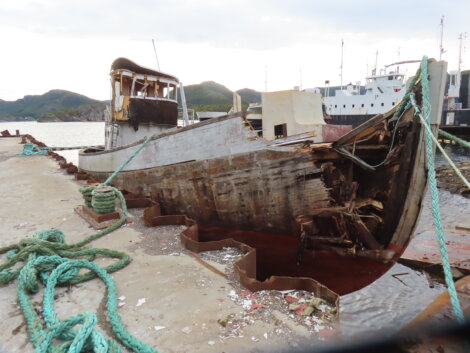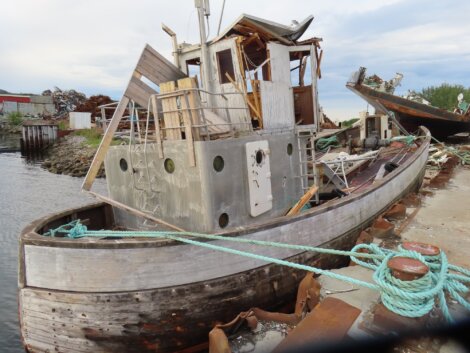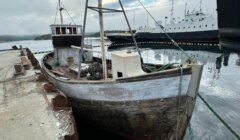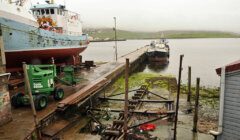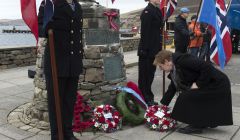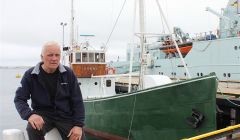History / Donations plea made as time begins to run out for Shetland Bus boat
An online fundraiser has now been launched
A PLEA has been made for donations towards attempts to save a wartime Shetland Bus boat from the scrapheap as time appears to be ticking out.
A team of interested parties are keen to try to take Vita out of the water and away from a Norwegian shipbreaking yard.
But despite interest being shown in saving Vita there appears to have been damage incurred to the historic boat at the yard.
She was one of the fishing boats used in the World War II Shetland Bus operation.
Vita was sent to be scrapped because the Norwegian museum which owns her was not able to raise enough money to continue to keep the boat in its collection.
Cally Fleming, from Mull, sought to raise interest in the story of Vita to see if the boat could potentially be saved.
She said over the past few weeks a small group of enthusiasts from Shetland, the rest of Scotland, Norway and the United States have been working to try to save Vita until options to save the historic vessel have been fully assessed.
Fleming has experience, having helped to raise £1 million in the past to restore and run a 54ft research vessel in the West of Scotland.
She said a number of people have offered support in “many ways” after hearing about Vita’s story.
But Fleming said the group were a week into discussions with Vita’s owners and the shipbreaking yard when the boat appeared to be damaged, including a hole in her bow, which can be seen in the photo above.
The group then organised for shipwrights from elsewhere in Norway to view Vita, and they informed them that if a metal frame and aluminium panels were installed she could potentially be refloated and towed to a nearby yard.
Become a member of Shetland News
However after subsequent talks it has been decided that Vita’s integrity would be put in question if she was towed – with the only viable option deemed to be lifting her out of the water.
Fleming added: “Of course, Fosen Gjenvinning will rely very much on scrappage fees for their running costs.
“Were we to rescue her, an appropriate amount could be included in the restoration costs.
“We understand that Fosen Gjenvinning is a business and that every boat that is towed in for scrapping can’t be towed out again, but a boat of such historical importance surely can be given a second chance, if a suitable renumeration for handling costs is made.”
She said the group of interested parties was now making one final plea.
“If we can raise funding for a barge and lifting equipment, we can get her to a yard, where future possibilities can be discussed and restoration plans made,” Fleming said.
“We are now running out of time and Vita will be scrapped within the week, if we can’t make this final concerted effort to save her.
“We understand that this will now require much more funding than if we were to tow her, and we are looking for experts in this field, in all likelihood in Norway, to reach out and make contact with us.
“We are looking for donations and offers of expertise and contacts of yards that may be able to store her for a cost, while plans are made. With what she has been through in her 85 years of history, this is a setback and whilst the damage is bad, she will have to be stripped back anyway.
“If we are not successful in rescuing Vita, we can return large donations or discuss options to support the remaining couple of Shetland Bus boats in existence and museums telling their story, including Scalloway Museum and the Shetland Bus Friendship Society.
“If you can help, please contact callyfleming@gmail.com or call 00447795177571.”
Online donations can also be made through this link.
The Shetland Bus operation played a crucial role during the World War II German occupation of Norway.
Under the cover of darkness, small boats – collectively known as the Shetland Bus – ferried people and weapons between Shetland and Norway, with Scalloway ending up being used as the operational base after initially starting at Catfirth before moving to Lunna.
It first operated using fishing boats, but not all those trips were successful, and 44 lives were lost during the crossings. However, the introduction of sub-chaser ships in 1943 brought an end to the fatalities.
In total more than 200 missions were carried out by the end of the war.
The Kystmuseet museum website says the 17.42 metre Vita was built in 1939 in Norway.
A year later and the boat was drafted into the Shetland Bus operation, with its first trip to Shetland in May 1940.
She was one of the first boats used to escape Norway after the German invasion there in 1940. Vita was skippered by Ingvald Johansen for most of her journeys.
Vita undertook eight trips to Norway but was captured by Germans in 1941, with her crew imprisoned for four years. However, the refugees Vita was carrying managed to escape.
SHe was then put into use as a guard boat, meaning she actually served both sides of the war.
Vita was later found in Kristiansund in poor condition and restored, reverting back to her original purpose of fishing.
In the 1980s Vita was sold under the new name Thule, and operated as a fishing boat for a few more years. In the early 1990s she was declared worthy of conservation by the authorities, and had to be owned by a museum or foundation.
Since then, further restoration work was carried out to Vita but in more recent years her condition has faltered, leading to the move to scrap her.
Become a member of Shetland News
Shetland News is asking its many readers to consider paying for membership to get additional features and services: -
- Remove non-local ads;
- Bookmark posts to read later;
- Exclusive curated weekly newsletter;
- Hide membership messages;
- Comments open for discussion.
If you appreciate what we do and feel strongly about impartial local journalism, then please become a member of Shetland News by either making a single payment, or setting up a monthly, quarterly or yearly subscription.






